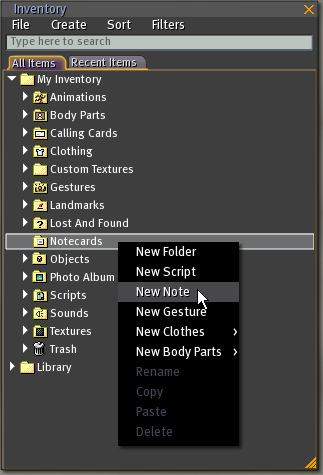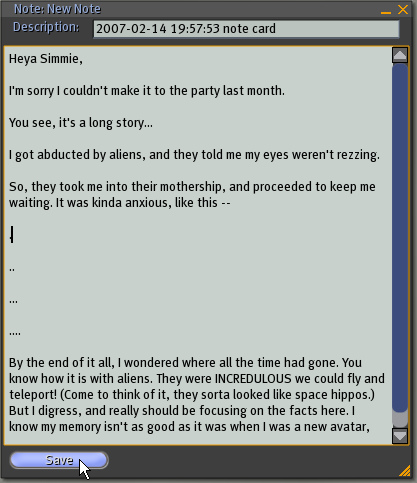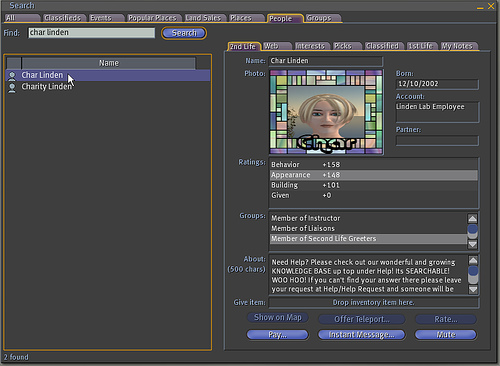KB2/Creating notecards
- http://wiki.secondlife.com/wiki/How_can_I_attach_a_landmark_or_inventory_item_to_a_notecard%3F
- http://wiki.secondlife.com/wiki/How_to_create_and_send_a_notecard_-_with_Video_Tutorial
How to create and send a notecard
In Second Life, notecards can be a way to deliver more extensive information that won't fit in a single IM (Instant Message). While notecards are often used to communicate various info like product manuals, your Inventory window's Notecards folder can also be used like an email box -- to send and receive long messages.
Watch this video and keep reading to learn more:
<videoflash type="vimeo">4168986|640|480</videoflash>
Creating a notecard
In your Inventory, simply right-click anywhere and select New Note, or go to the menu at the top of the Inventory window and select Create > New Note.
The New Note will pop up. Now, you should write something appropriate.
When you're done, click Save and close the notecard by clicking the X. To rename the notecard, right-click it in your inventory, select Rename, and type in a more personalized title.
Sending a notecard
Now that you've got your notecard written, you may want to send it to someone. There are several ways to accomplish this:
- If you're standing close to them, drag the notecard from your inventory to their avatar.
- If they're on your Friends list, click their name in the Friends window and click Profile.
- If they're on your Friends list, click the IM button at the bottom of the Second Life window. In the New IM tab, double-click their name, and you'll see a Profile button to the right of the IM chat bar.
- If neither apply, then the most basic way is to click the Search button at the bottom of the screen and click the People tab. Search for their name, and their profile will show up in the right pane.
Now, with both their profile and the notecard in your inventory visible, drag the notecard onto anywhere on their profile -- you'll notice it highlights to indicate you can let go of the mouse button.
Do that, and your notecard is sent! If they're online, you'll receive confirmation they got it, and if they're offline, you'll see this:
Receiving a notecard
When you log in, you can check for new notecards -- like new mail -- by opening the Inventory window's Notecards folder. You can read any notecards inside by double-clicking on them. To reply, you can send a quick IM, or if the reply needs to be longer, you can send a notecard back!
Embedding items in a notecard
Similar in function to email attachments, you can drag-and-drop fully-permissive (Modify, Copy, and Transfer permissions must all be enabled) items from your inventory to a notecard. They can be landmarks, objects, scripts, etc.
For more information on attaching items to a notecard, see How can I attach a landmark or inventory item to a notecard?
How to attach a landmark or inventory item to a notecard
Did you know you can attach nearly any type of inventory item to a notecard? Attached images and landmarks can make a fabulous addition to informational notecards, and notecards-within-notecards can provide you with some interesting options for organizing your text.
To attach an inventory item to your notecard:
- Open a notecard you own or create a new notecard.
- Make sure the item you wish to attach is fully permissive. The next owner permissions must allow copy, modify, and transfer.
- Drag the item from your Inventory window onto the notecard window. You can drop in any kind of inventory item, excluding calling cards.
- The item appears as a hyperlink in the notecard. You've done it!
Troubleshooting
If Second Life does not allow you to drop the item into your notecard, make sure to check the permissions on the object. If applicable, also check the permissions on any inventory items contained inside the object. A notecard will only accept fully permissive attachments, so it is not a good idea to attach anything you do not want other people to copy.



